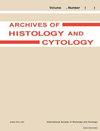Expression patterns of T1R3 in duodenal epithelial cells with some gastrointestinal hormone
Q4 Medicine
引用次数: 1
Abstract
tract (GI) (Hofer al ., 1996; Wu al ., 2002; Dyer al ., 2005; Grundy, 2005). They are additionally expressed in the stomach, small intestine – including the duodenum, and colon in mice and humans, with the exception of T1R2, which has not been detected in the mouse or human stomach or in the mouse colon (Bezençon et al ., 2007). There have been Summary. Recent studies have demonstrated that taste receptors, T1Rs and T2Rs, are expressed not only in taste buds but also in the gut. In the duodenum, it is thought that the secretion of secretin (S cells) and somatostatin (D cells) is stimulated by acid, that gastrin (G cells) and cholecystokinin (CCK) (I cells) are stimulated by proteins and amino acids, and that serotonin (EC cells) scretion is triggerd by mechanical stimulation sensing gut endocrine cells. We examined the expression of T1R3 in the duodenum by reverse transcription polymerase chain reaction (RT-PCR) and in situ hybridization. Double-label studies showed that approximately 50% of secretin positive cells (S cells) were coexpressed with T1R3, and approximately 33% of AADC positive cells (EC cells) were coexpressed with T1R3. On the other hand, T1R3 never colocalized with somatostatin (D cells), gastrin (G cells), or CCK (I cells). These results suggest that S cells may regulate the secretion of secretin, stimulated not only by acid but also by sweet substances and/or amino acids. of the circumvallate papilla (CV) and the duodenum, amplification products of the expected sizes were obtained with primer sets specific for T1R3 (610bp). On the other hand, amplification products were not obtained using RNA prepared from the epithelia of the duodenum without reverse transcription, which was performed as a negative control. β -actin was used as a control. suggest胃肠激素作用下十二指肠上皮细胞T1R3的表达模式
tract (GI) (Hofer al ., 1996;吴等,2002;Dyer al ., 2005;心胸狭窄的人,2005年)。除了T1R2外,它们还在小鼠和人类的胃、小肠(包括十二指肠)和结肠中表达,T1R2未在小鼠或人类胃或小鼠结肠中检测到(bezen等人,2007)。有总结。最近的研究表明,味觉受体T1Rs和T2Rs不仅在味蕾中表达,而且在肠道中表达。在十二指肠,分泌素(S细胞)和生长抑素(D细胞)的分泌被酸刺激,胃泌素(G细胞)和胆囊收缩素(CCK) (I细胞)的分泌被蛋白质和氨基酸刺激,血清素(EC细胞)的分泌被感应肠道内分泌细胞的机械刺激触发。我们通过逆转录聚合酶链反应(RT-PCR)和原位杂交检测了T1R3在十二指肠中的表达。双标签研究表明,约50%的分泌素阳性细胞(S细胞)与T1R3共表达,约33%的AADC阳性细胞(EC细胞)与T1R3共表达。另一方面,T1R3从未与生长抑素(D细胞)、胃泌素(G细胞)或CCK (I细胞)共定位。这些结果表明,S细胞可能调节分泌素的分泌,不仅受到酸的刺激,还受到甜物质和/或氨基酸的刺激。用T1R3特异性引物组(610bp)扩增出了预期大小的环状乳头(CV)和十二指肠的扩增产物。另一方面,从十二指肠上皮细胞制备的RNA未经反转录,作为阴性对照,未获得扩增产物。β -肌动蛋白作为对照。建议
本文章由计算机程序翻译,如有差异,请以英文原文为准。
求助全文
约1分钟内获得全文
求助全文
来源期刊

Archives of histology and cytology
生物-细胞生物学
自引率
0.00%
发文量
0
期刊介绍:
The Archives of Histology and Cytology provides prompt publication in English of original works on the histology and histochemistry of man and animals. The articles published are in principle restricted to studies on vertebrates, but investigations using invertebrates may be accepted when the intention and results present issues of common interest to vertebrate researchers. Pathological studies may also be accepted, if the observations and interpretations are deemed to contribute toward increasing knowledge of the normal features of the cells or tissues concerned. This journal will also publish reviews offering evaluations and critical interpretations of recent studies and theories.
 求助内容:
求助内容: 应助结果提醒方式:
应助结果提醒方式:


